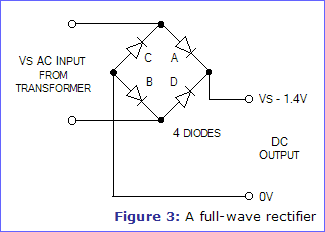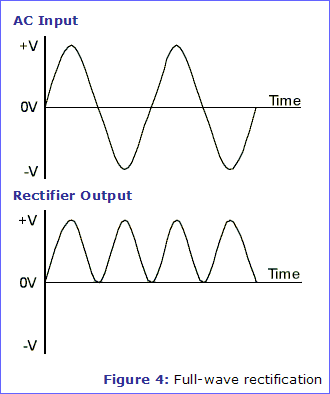The output of the half-wave rectifier is DC (it is all positive), but it is not a good a power supply for a circuit as the output voltage continually varies between 0V and Vs-0.7V. Further, half the time there is no output at all.
The circuit in figure 3 addresses the second of these problems. Here, output voltage does not remain 0V at any time. Here, four diodes are arranged in such a way that both the positive and negative parts of the AC waveform are converted to DC. The resulting waveform is shown in figure 4.
 When the AC input is positive, diodes A and B are forward-biased, while diodes C and D are reverse-biased. When the AC input is negative, the opposite is true - diodes C and D are forward-biased, while diodes A and B are reverse-biased.
When the AC input is positive, diodes A and B are forward-biased, while diodes C and D are reverse-biased. When the AC input is negative, the opposite is true - diodes C and D are forward-biased, while diodes A and B are reverse-biased.
While the full-wave rectifier is an improvement on the half-wave rectifier, its output still isn't suitable as a power supply for most circuits since the output voltage still varies between 0V and Vs-1.4V. So, if you put 12V AC in, you will 10.6V DC out.

Excellent explanation. Since exact calculation of current peak or true RMS of diode bridge is very hard due to high nonlinearity, some numerical simulation can be helpful.
ReplyDeletehttp://www.cirvirlab.com/simulation/diode_bridge_online.php